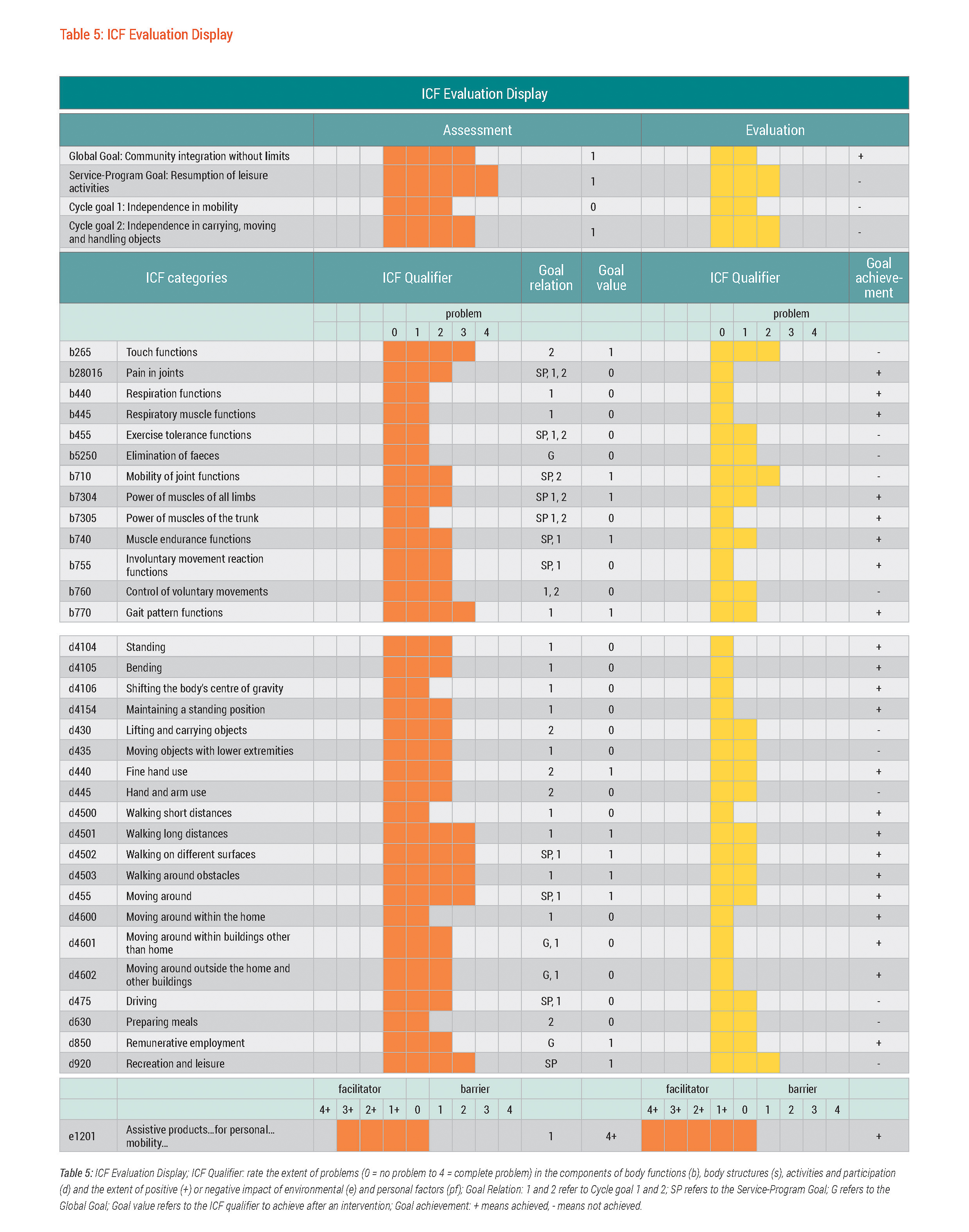Evaluation
I never expected to make so much progress so quickly. Now I can swim and ride a bike, but there are still some challenges. I’m nervous while swimming and can’t yet get onto a mountain bike, which I find really disappointing. But I know these will also improve with time and practice.
Simon at the end of the Rehab-Cycle®
Despite the overall improvement in Simon’s functioning as well as in most of the intervention targets defined, these gains were not sufficient to meet the cycle goals. Simon fell just short of achieving the goal values set at the start of the Rehab-Cycle®. Nevertheless, his outlook for the future remained positive.
Over the two-month course of this Rehab-Cycle®, there were measurable improvements to his condition. Most importantly, the overall improvement of his condition was reflected in an upgrade of his ASIA score. Simon’s ASIA score went from ASIA A at admission (complete lack of motor and sensory functions below his injury) to ASIA D, meaning that his motor functions below the injury level were preserved with active movement and full range of motion against gravity in at least half of the key muscles.
""...the overall improvement of his condition was reflected in an upgrade of his ASIA score.""
The positive results of the interventions intended to improve Simon’s walking ability was evident in the transformation from total paralysis to normal active movement, full range of motion and full resistance in a functional muscle position for some muscles, as well as the sychronised gait pattern and control of voluntary movements. These advances contributed to the overall improvement of his walking ability. Simon could now walk independently for up to 15 minutes.
""Simon could now walk independently for up to 15 minutes.""
However, due to Simon's reduced muscle strength and endurance, he experienced limits to his walking ability. For example, he needed to use crutches if he walked longer than 15 minutes. Furthermore, walking on uneven surfaces such as grass or sand continued to present difficulties resulting from an impaired ability to sense and recognise the relative position of his body. He also continued to have problems with exercise tolerance. Moreover, due to spasticity and reduced strength in his left leg Simon continued to have some problems with driving.
Despite continued problems Simon also acknowledged his gains. For example, due to his improvement in balance and reaction functions he felt more secure walking without assistive devices. To accommodate for continued problems in walking, Simon used a wheelchair and crutches for moving around outdoors and for long distances.
His therapists were also please with his improved independence in walking and moving around even though cycle goal 1 was not met.
Simon improved his balance and reaction functions significantly over the past two months. His risk of falling has also decreased, especially on even surfaces and over short distances. He still needs to improve walking on uneven ground.
Simon’s occupational therapist at the end of the Rehab-Cycle®
The problems that Simon continued to experience as well as the improvements in his functioning were documented using the ICF Evaluation Display, a "before and after" visualisation of Simon's functioning at the the begining and at the end of the Rehab-Cycle®. It also shows whether the goals were achieved. See table 5.

Table 5: ICF Evaluation Display; ICF Qualifier: rate the extent of problems (0 = no problem to 4 = complete problem) in the components of body functions (b), body structures (s), activities and participation (d) and the extent of positive (+) or negative impact of environmental (e) and personal factors (pf); Goal Relation: 1 and 2 refer to Cycle goal 1 and 2; SP refers to the Service-Program Goal; G refers to the Global Goal; Goal value refers to the ICF qualifier to achieve after an intervention; Goal achievement: + means achieved, - means not achieved.
The interventions intended to address cycle goal 2 ‘independence in carrying, moving and handling objects’ targeted sense and touch functions, lifting and carrying ability, hand and arm use. Based on a dynamometre analysis, Simon confirmed increases of up to 50% of his pre-Rehab-Cycle values in muscle power in both hands. While this represented a significant gain, Simon's muscle power in the hands was still less than half of the hand force produced by men without spinal cord injury (SCI).
The combination of weak muscle power and absence of sensitivity made it difficult for Simon to carry out some work tasks such as exchanging a printer cartridge or rolling up a cable. Nevertheless, he felt confident in many other daily tasks requiring the use of his hands and arms such as preparing simple meals.
While Simon’s shoulder mobility, fine hand functions and muscle power improved considerably, his touch functions showed no change since the start of the Rehab-Cycle®. This will limit activities requiring fine hand use.
Simon’s physical therapist, at the end of the Rehab-Cycle®
At the end of the Rehab-Cycle® the rehabilitation team evaluated whether the service-program goal they set with Simon i.e. resumption of leisure activities was achieved. Unfortunately, he was unable to fully achieve his hopes of resuming his participation in pre-injury leisure activities. For example, rather than being able to mountain-bike again at the end of the Rehab-Cycle®, Simon was only able to ride a woman’s bike, whose frame configuration made it easier for him to mount it. Regardless, Simon experienced successes in his service-program goal, bringing him closer to his ultimate global goal of community integration without limits.